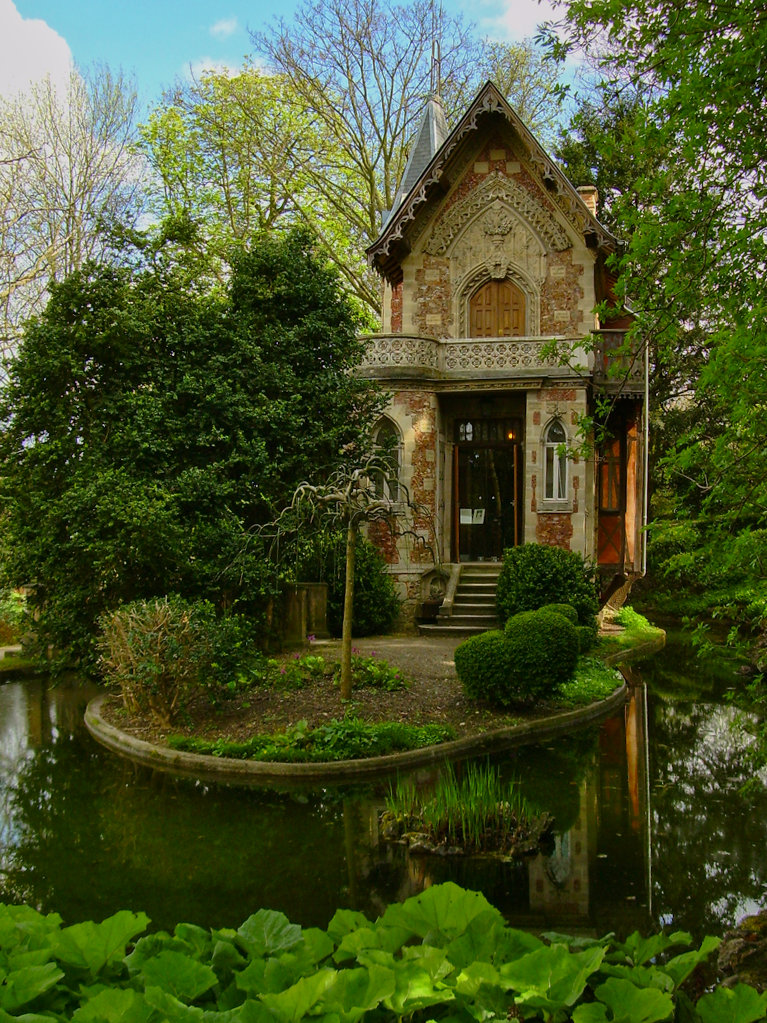Bonjour readers. Today we are in France, a little beyond Paris, visiting the so-called Chateau Monte Cristo. This was built by Alexandre Dumas père, one of the most successful novelists of the nineteenth century. Begun in 1846 and finished in 1847, the Château’s design was commissioned from Hippolyte Durand, the leading architect of the day, as something reminiscent of the Renaissance. The towers are surmounted by Dumas’ initials carved in stone, together with his personal motto, and the head of Dumas himself appears amongst the series of heads of other famous writers (Shakespeare, Virgil, Goethe) which decorate the exterior at first floor height, looking out over the front door. The Château itself, then, is entirely fitting for a writer specialising in historical subjects like Dumas, a best-selling exponent of historical fiction.
If you follow the winding path up the slope behind the Château through the parc anglais (‘English park’), threading through artificial rock arches and grottoes alive with the trickle of streams and pools, you find a miniature Gothic castle set on a miniature island, surrounded by a spring-fed moat. Reached by a stone bridge, and guarded at its entrance by a stone dog chained in a kennel, this is Dumas’ ‘cabinet de travail,’ or ‘study’ to English folk. It was commissioned as a gothic pavilion surrounded by water, and is set with stones carved with the titles of eighty-eight of his works. Dumas called it the ‘Château d’Îf’.
The author most famously of The Three Musketeers (1844) and The Count of Monte-Cristo (1845-6) has of recent years largely fallen out of the French literary canon. But I am old enough to have read many of the French popular classics serialised at length in graphic form in the children’s weekly Look and Learn, and as a result the events of The Count of Monte-Cristo are burnt into my memory – the unjust imprisonment of the hero Dantès as a supporter of Napoleon during the Hundred Days, his fourteen years in solitary confinement in the island prison of the ancient Château d’Îf in the bay of Marseilles, his eventual escape enabled by his substituting of himself for the dead body of his fellow-prisoner, friend and mentor, the Abbé, and his subsequent acquisition of the fabulous treasure of Cardinal Spada hidden within the labyrinthine series of grottoes of the island of Monte Cristo. Even read at full length (three fat volumes), it is a compulsive page-turner. It was also a founding romance for post-Napoleonic France. It was wildly successful both in France and in Britain, and the money it brought in funded the building of Dumas’ palace and its grounds. The site was dubbed the ‘Château Monte Cristo’ by a friend, and with good reason, for the imagination of the author of The Count of Monte Cristo is very clearly at work here.
Within Dumas’ novel, the Château d’Îf is indeed something of a ‘cabinet de travail’; the imprisoned Abbé occupies himself reading and studying and teaching Dantès, ingeniously contriving paper, pens, penknife and ink from two old shirts, fish-head cartilage, a broken candlestick, and a mixture of soot, blood, and communion wine. Despite the privations of his cell he has an extensive library of memorised books: ‘Thucydides, Xenophon, Plutarch, Titus Livius, Tacitus, Strada, Tornandes, Dante, Montaigne, Shakespeare, Spinoza, Machiavel, and Bossuet’. So, you might say that Dumas’ Gothic tower is at once the most sumptuous of writer’s sheds, a description of the privation of the writer’s life, and a description of writerly ingenuity, which spins treasure from mind, body, and basic materials. Dumas was in fact far more fussy about his studying implements than the Abbé could afford to be: he wrote in his essay ‘Ah vous voilà Dumas!?’, printed in Mon Odyssée à la Comédie Française in 1856: ‘I am maniacal on this point; I cannot work without a certain sort of paper, I cannot write without certain sorts of pens, it is impossible for me to write anything with blue ink’. And, by further contrast, Dumas, unlike the Abbé, was of course free to leave his prison when he chose, rather than being released only by death.
The stream that flows downwards from Dumas’ ‘cabinet de travail’ forks: one stream feeds the ‘pool of Haidée’; the other runs directly under the Chateau Monte Cristo and into a ‘bassin de dragon’ which pours out below the terrace and into what was once an extensive view across the river-plain of the Seine. In Dumas’ time the grounds were filled with monkeys, golden pheasants, peacocks, parrots and a vulture. Symbolically, it is the writer’s confinement within the Chateau d’If which is the source of this Eden-resembling domestic bliss. So, while the Chateau d’If, as purpose-built writing-space, describes writing as imprisonment, the ‘parc anglais’ that surrounds it describes the pay-off: it shows Dumas, like the protagonist of The Count of Monte Cristo, to have come into possession of fabulous wealth as a direct result of his years of captivity.

